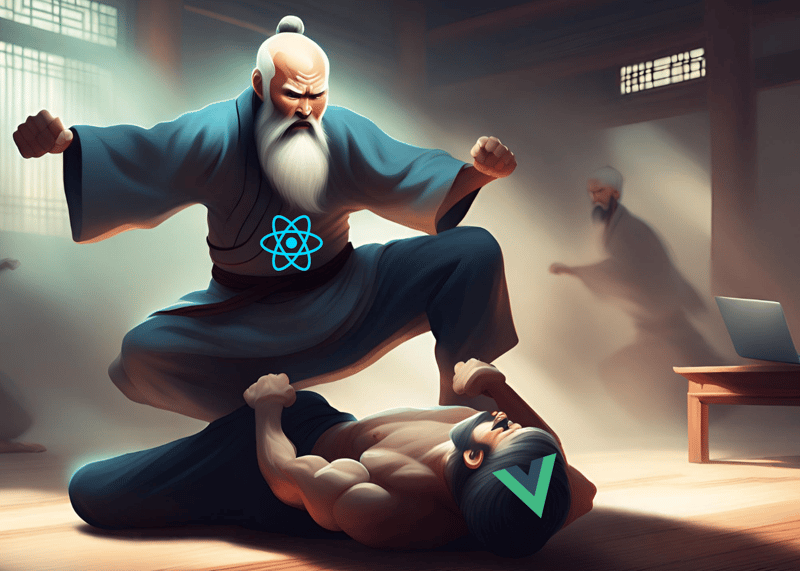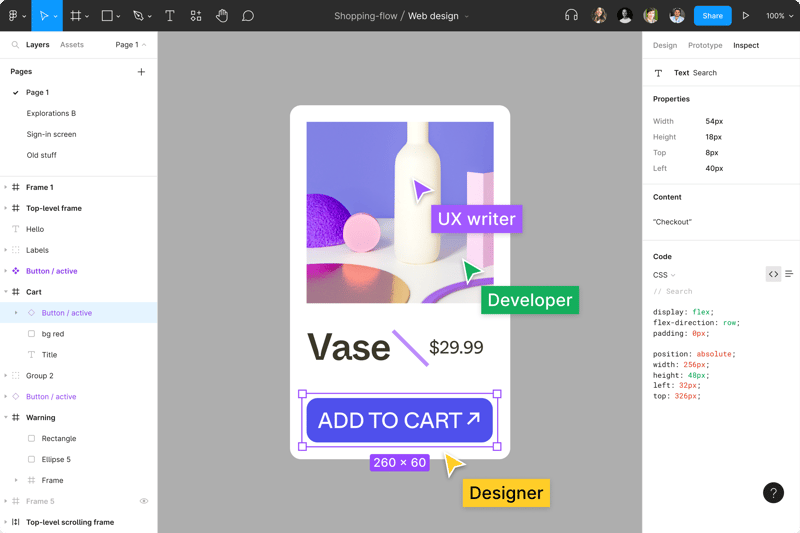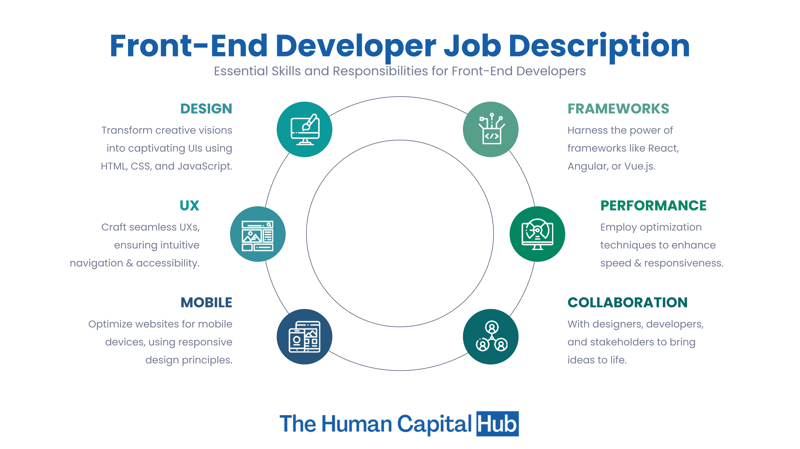React is the most popular JavaScript library for building single-page applications. On the other hand, Vue.js claims to be the framework. They share more in common than, for example, Angular, which is a “true” framework. 🚩
In this article, I am going to make a detailed comparison between React.js and Vue.js so that you can decide which JS framework/library is BEST for you. 🚧
⚖️ Framework Overview
React was created by Jordan Walke, a software engineer at Facebook. Currently, it is maintained by Meta (formerly Facebook) and a community of individual developers and companies.
Its rich ecosystem and flexibility make it a perfect choice for building complex user interfaces and handling data processing tasks.
Additionally, React Native, an extension of React.js, enables developers to create hybrid mobile applications with ease.
..On the other hand, Vue.js, a relatively newer entrant, created by Evan You after working for Google using AngularJS in several projects. Vue focuses on simplicity and efficiency in UI design and development.
🧹🫧Its intuitive syntax and clear design principles make it appealing to developers seeking a straightforward framework for building interfaces.
Vue.js also offers built-in features like animation and state management through Pinia which serve a wide range of development needs.
🍏 Reasons for Using Vue.js
Vue.js has gained attention for its simplicity. Developers appreciate its clear and logical design, which speeds up the development process and workflows.
Unlike some other frameworks, Vue.js maintains a consistent syntax throughout the UI functionality.
One of Vue.js' strengths lies in its efficient official plugins, which offer solutions for common tasks like routing.
⚠️ Most importantly, Vue.js operates as an independent framework without corporate backing, which may appeal to developers concerned about data exploitation by large tech companies.
⚛️ Reasons for Using React
React.js has some unique features that make it a popular choice among developers.
The JSX syntax simplifies the creation of custom components. 📂
JSX stands for JavaScript XML. JSX allows us to write HTML in React. JSX makes it easier to write and add HTML in React.
It is just an XML-like extension that allows us to write JavaScript that looks like markup and have it returned from a component.
Moreover, React.js offers strong support for search engine optimization (SEO), ensuring that web applications built with React.js are easily discoverable and indexable by search engines.
Another advantage of React.js is its support for mobile development through React Native. Developers familiar with React.js can improve their skills to build native mobile apps using the same syntax and development patterns used in React.js.
Additionally, React Developer Tools provide invaluable assistance in organizing and debugging code.
🥇 Comparison of Popularity and Performance
Both React.js and Vue.js have witnessed significant demand within the developer community, but React.js currently holds a slight edge in terms of popularity. Its larger user base and extensive ecosystem contribute to its widespread use in various projects and industries.
🛰️ In terms of performance, both frameworks provide virtual DOM for efficient rendering of HTML pages. 📟
This approach ensures that UI updates are fast and responsive.
However, Vue.js tends to excel in component creation and updates, thanks to its streamlined approach to optimization.
🔎 The Statista survey report reveals that 42.62% of developers have chosen React.js whereas 18.82% of developers have used Vue.js. for web development
🧊 Scalability
Scalability is a crucial factor for frameworks handling large and complex applications.
React.js offers a scalable architecture through the concept of "smart" and "dumb" components.
🔹Smart components manage performance-related tasks and orchestrate interactions with dumb components, which focus on rendering UI elements based on input data.
Vue.js provides a similar approach to scalability, with support for state management through Pinia and other official libraries. This allows developers to efficiently manage state changes and ensure optimal performance as their projects grow in complexity.
📲 Adjust to Mobile Devices
Both React.js and Vue.js provide solutions for mobile development to meet the growing demand for cross-platform applications.
React Native, a mobile development framework based on React.js, allows developers to build native iOS and Android apps using familiar React.js patterns.
Vue.js supports Weex, a mobile UI framework developed by Alibaba Group, which enables the creation of iOS and Android apps using Vue.js components.
While Weex may not enjoy the same level of popularity as React Native, it offers a viable option for developers seeking a Vue.js-centric approach to mobile development.
🚎🔩 Size and Community Support
The size of a framework can significantly impact its performance and load times.
Vue.js has a smaller default size compared to React.js, making it an attractive option for projects where optimization is a priority.
Additionally, Vue.js provides essential features out of the box. For example, it reduces the need for additional library downloads.
In terms of community support, React.js benefits from backing by Facebook and an active open-source community. However, Vue.js has also gained traction among developers, thanks to its user-friendly design and extensive documentation. While React.js may have a larger community, Vue.js' growing popularity indicates its potential for long-term success.
🏒 Use Cases
Both React.js and Vue.js are versatile frameworks with a wide range of use cases.
React.js mostly used in building social media platforms, complex web applications, and projects requiring seamless integration with React Native for mobile development.
Vue.js, on the other hand, is well-suited for small to medium-sized web applications, real-time platforms, and content delivery platforms. Its fast performance and easy maintenance make it a popular choice among developers seeking a lightweight framework for rapid development.
🏇 Recommendation:
Did you know that the majority of developers and UI/UX designers use a fantastic design tool called Figma to create web design components and mockups/prototypes for websites or apps? It became the most popular design tool (RIP Adobe XD) for developers due to its all-in-service:
- ⚓ Super Clean UI Design (Figma)
- 🎈 Collaboration with Other Team Members (FigJam)
- 👨💻 Developer Mode (Figma Pro)
- 🤖 Creating AI UI/UX Templates in no time (FigJam AI & Plugins)
As a frontend developer, having some design skills is required since job recruiters often seek candidates with such capabilities. Fortunately, with FigJam AI, you don't need to master advanced design skills. FigJam AI offers tips to enhance your designs, automates tedious tasks, and best of all, it's currently available for free to everyone.
👏 Conclusion
In conclusion, both React.js and Vue.js offer unique strengths and advantages for front-end development projects. React.js wins with its versatility, robust ecosystem, and support for mobile development. It's a top choice for developers working on complex applications.
Vue.js, on the other hand, stands out for its simplicity, efficiency, and fast performance. Its intuitive syntax and efficient design make it an excellent option for developers seeking a lightweight framework with minimal overhead.
Thanks for reading this article. If you like this article, you may also like my 𝕏 account for more lessons on frontend development.
Related articles:


























